If you have ever visited Piedmont, Italy’s famous wine region, you have probably sampled the local specialty known as agnolotti al plin. These tiny handmade ravioli are sealed with a pinch (“plin” in local dialect).
Archive for the ‘Food’ Category
4 Feb
Focaccia Simple Breads From the Italian
by Carol Field
This is a great fun book on Focaccia. The topic of pizza is widely covered by books and other media but Focaccia is lost in the bread universe. The reading of this book will introduce you to the many varieties and also pique your interest in a strong competition for pizza lovers. The text has many recipes and the sections on making pizza and its background have good details. I strongly recommend this book.
4 Feb
Wine Made Easy: How to Taste*Wine Styles*Wine & Health*Understanding Labels*Wine & Food
by Susy Atkins 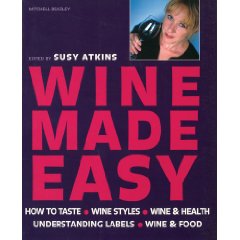
This is an introductory book for anyone interested in wine knowledge. The layout of the book makes it extremely readable and easy to follow. The information provided is very broad and covers all the basics and related topics but is primarily a survey text. Anyone who likes wine or interested in learning from the basics will find this book very handy and useful. I recommend it as a great book for absolute beginners or slightly more knowledgeable learners of wine.
4 Feb
He Said Beer, She Said Wine: Impassioned Food Pairings to Debate and Enjoy — From Burgers to Brie and Beyond
by Marnie Old (Author), Sam Calagione (Author) 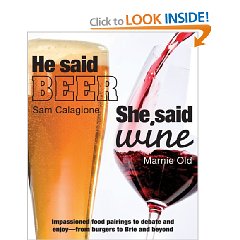
He Said Beer, She Said Wine is a relatively useful matching book that emphasizes not only wine and food but also beer and food. The creative authors’ team of a brewer and a sommelier each partial toward one’s own beverage gives the reader a good handle on the topic. The layout and the arrangement of the book is strong and the examples are rich. The book relies heavily on the beverage side and is definitely written for the general public and not the professionals in the field. The wine and beer labels offered as examples are large productions known for their commercial presence and usually more of a beverage store (supermarket) volume stock than a fine restaurant beverage list. The authors’ arguments and the details for the products are good. And the discussion of beer-matching truly expands your culinary horizons even if you are settled in wine choices with your food. I strongly believe the idea of the book was born as one of a commercially successful matching book (with an eye to selling specific labels) rather than one of a strong (and possibly scholarly) contribution to the branch of the field. Nevertheless, He Said, She Said is a good book and you should read it once and consult in the future for guidance. I recommend it.
4 Feb
Far East Cafe: The Best of Casual Asian Cooking (Casual Cuisines of the World)
by Joyce Jue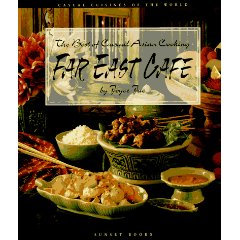
Far East Cafe is another primer and East Asian food is well-covered here. The recipes and the photographs are the strongest part of the book. The introduction to the cuisine and the food is good. And the book is most enjoyed if you have some familiarity with East Asian food and like it. It is a good book on Asian cooking in general though intended to cover casual cooking. I recommend it.
4 Feb
Diner: The Best of Casual American Cooking (The Casual Cuisines of the World) (Hardcover)
by Diane Rossen Worthington (Author), Allan Rosenberg (Author) 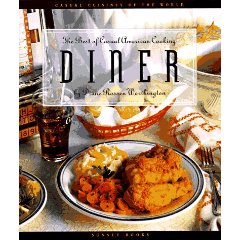
A good book on the good old Diner that was once appreciated and now carries the stigma of unhealthy food. The recipes are quite good and the pictures are awesome may be because it is hard to find any photographs in this book that does not bring back many good memories. The introduction is well-done and the book is a good collection of recipes for casual American food. I recommend this book.
4 Feb
Pizza: A Global History (RB-Edible)
I loved this book and hope the other volumes are released shortly. I never thought I would have an interest in book on the history of pizza but after reading dozens of texts about pizza-making I found the material included extremely interesting and useful. I don’t consider this book a bona fide history of pizza but rather one way of relaying some of its background. History books are generally biased and filled with falsities. Pizza: A Global History is no exception but is at the same time interesting. If you have serious interest in pizza, you can develop a good perspective on pizza within the culture and the life of its world by reading this book. I recommend it strongly as long as you do not misunderstand its shallowness.
18 Jan
The Pizza and Pasta Cookbook
by Sarah Bush (Author), Lesley MacKley (Author), Jon Stewart (Photographer), Alister Thorp (Photographer), Kay Small (Photographer) 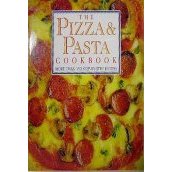
This book is very tall and wide in size but thin in thickness. The first half covers the short pizza recipes with color photos next to the ingredient lists. The recipes are very basic and the minimum one can find to make the pizzas. The second part of the book is on pasta. Many pasta dishes are presented with very beautiful pictures and tiniest recipes. The cookbook includes 250 recipes in its short number of pages and barely makes it as a useful cookbook. The book may be very pretty but the content is weak.
29 Nov
Pairing Wine and Food: A Handbook for All Cuisines
See this book on Amazon »
“The debate over the proper matching of wine and food is far from being settled in Pairing Wine and Food. The efforts to write useful books on this subject are not many but neither rare. If you are enthusiastic about wine to the extent of desiring more through a good match, you will have difficulty putting together a library of books on the subject. In my personal view, since matching is more of an art than science, it has done its best experientially rather than methodically. Pairing Wine and Food is not a definitive text nor does it claim to be. Linda Johnson-Bell writes as comprehensive a matching book as possible within the limits of her personal experiences. The backbone of the text is her effort to accentuate what knowledge of wine and food he possesses toward the end of great matching. She explores viniculture, viticulture and food with a keen eye for characteristics if one is to match wine with food. The book may have no photographs but has there is no shortage of tables. A great many interesting topics are organized in tables for definition or matching. Some may find that to be her strength while others notice that half of the text is made up of these tables including a 63 page long matching table at the end. Are the matching tables definitive or are they merely useful and more than just interesting? I would settle for the latter. In conclusion, the non-matching writing is comprehensive though far from definitive and the matching information is only a way to explore since vintages come and go. I recommend reading once since good matching books are few but better books are in print.”

